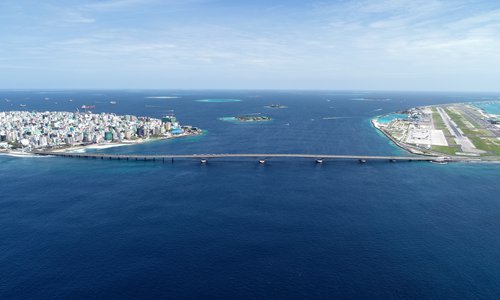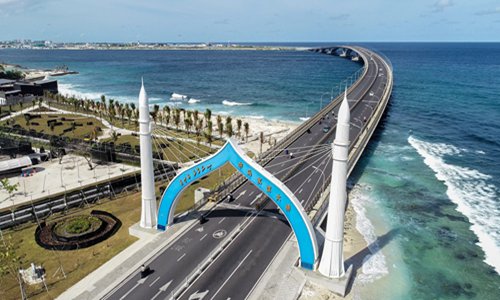HOME >> BUSINESS
China-Maldives Friendship Bridge refreshes Maldivian life
By Xinhua - Global Times Source:Xinhua-Global Times Published: 2019/9/4 17:38:40
Investment connects people and businesses in the island nation

An aeriel view of the China-Maldives Friendship Bridge linking the Maldivian capital of Male with neighboring island Hulhule on Friday Photo: Xinhua

An aeriel view of the China-Maldives Friendship Bridge linking the Maldivian capital of Male with neighboring island Hulhule on Friday Photo: Xinhua
The China-Maldives Friendship Bridge, the first cross-sea bridge in the Maldives and built by a Chinese company, marks the beginning of a new chapter for Maldivians.
The 2-kilometer bridge, inaugurated on August 30 of last year, links the Maldivian capital of Male with neighboring island Hulhule, where the nation's only international airport is located.
The bridge, an iconic China-Maldives co-building project for the 21st Century Maritime Silk Road, makes it possible for locals and tourists to travel between the two islands within five minutes.
On the first anniversary of the bridge's inauguration, Maldivians sang and danced on the bridge in celebration of the achievement.
For years, Maldivians have relied on ferries as their means of transport between the atolls in the Indian Ocean.
The Chinese-built bridge has not only brought convenience to the lives of Maldivians, but has also offered new business opportunities and new jobs to many residents living in Hulhumale, a reclaimed island developed for a housing complex, northeast of Hulhule and Male.
A Maldivian man, who lives in Hulhumale but works in Male, told Xinhua that it seemed like Male, Hulhule and Hulhumale had been linked as a city by the bridge.
The opening of the bridge has also increased economic vitality, as the auto-repair industry is prospering in Hulhumale. When Xinhua visited Maldivian Hassan Hakeem's auto-repair shop, a dozen vehicles were parked and waiting to be repaired.
Shop-owner Hakeem said that due to traffic restrictions, the car repair industry had not developed in the Maldives. "We firmly believe the opening of the bridge will bring us more business," he said. "In the past, all of our auto-repair shops in the Maldives imported a total of 300 or 400 tires every three months, but now Hulhumale alone needs to import more than 1,400 tires a month."
There are many famous cafes and restaurants in Hulhumale. Due to inconvenient traffic in the past, only the weekends or major holidays would see visitors from Male.
After the bridge was opened to traffic, the cross-island takeaway service has become standard for many food and beverage outlets.
Jelly Pizza is a chain restaurant that has several branches in Male. Its cross-island takeaway branch is located in a secluded alley, with couriers and four or five delivery motorcycles on standby.
Courier Jahanjir spoke to Xinhua just as he received an order to deliver a pizza within 30 minutes to a customer who lives in Hulhumale.
"I have to travel back and forth several times a day on the bridge because there are at least three or four trips to Hulhumale every day," he said.
Maisha, who is in charge of finance at the pizza store, said, "Our customers mainly live in Male. Now there is a bridge. Customers who live in Hulhumale also place their orders now. We are preparing to open a branch in Hulhumale."
The bridge has also generated new job opportunities for Maldivians.
There were no traffic lights and few traffic police in Male before the construction of the bridge. Now, traffic lights have been installed at both ends and there are bridge traffic police.
Traffic police officer Aleena has been working on the China-Maldives Friendship Bridge for eight months. She said, "When I first started on the bridge, I felt that many young people didn't pay much attention to traffic lights. Now they are very disciplined."
Yoosuf Rafeeu, previously a taxi driver, became a double-decker bus driver after the Maldivian government opened the Greater Male Bus Terminal (GMBT) last year.
"There are 23 buses in the GMBT, eight of which are double-decker buses. I am proud to be a rare double-decker bus driver in the Maldives," he said.
Bridge engineer Mohamed Shafeeu studied civil engineering in Malaysia and has worked in the ports and terminals of the Maldives. In 2017, he became responsible for the quality management of the bridge after joining a relevant government department.
"Compared with the port and dock projects, the construction of this bridge is more difficult. The engineers in China are very dedicated, and their hard work allows us to enjoy a happy cross-island life," he said.
Construction of the bridge was first agreed upon by China and the Maldives in September 2014. Ground was officially broken in March 2016 and the bridge was completed in July 2018.
As part of the agreement, the project, which was built at a cost of 1.26 billion yuan ($184.44 million), was largely funded by China through direct aid and discounted loans to the Maldives.
The Maldivian government shouldered the balance, according to a statement from the contractor, CCCC Second Harbor Engineering Company, a unit of the China Communications Construction Company.